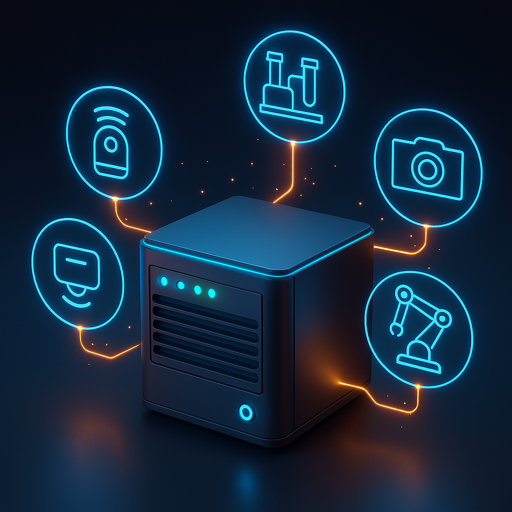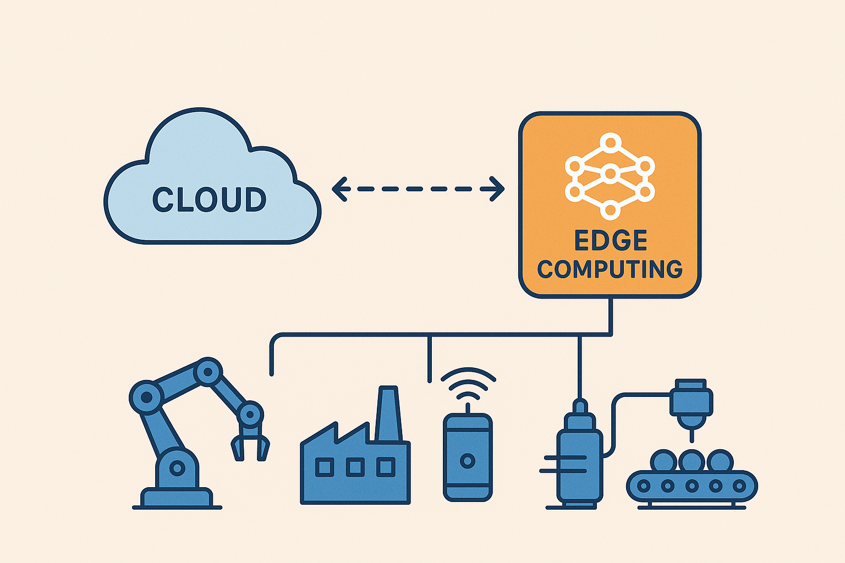This post may contain affiliate links. If you click through and make a purchase, we may earn a commission at no additional cost to you. This helps support our work and allows us to continue providing valuable content. For more information, please see our disclosure policy.

In simple terms, edge computing means processing data close to where said data is generated. Instead of sending everything to a remote server in a distant cloud for processing, decisions and analytics happen right there “on the edge,” like on a factory floor or at an oil rig. For the Industrial Internet of Things (IIoT, for short), this approach is especially important because you often need real-time insights to keep operations running smoothly and efficiently.
Defining Edge Computing
We can think of edge computing as having a small, capable on-site team that handles day-to-day tasks, while a bigger corporate office (the cloud) only steps in for major decisions or long term planning. Because data is processed locally:
- There is less reliance on a stable Internet connection.
- Insights are gained faster (less lag or latency).
- Sensitive data can be better controlled.
Typically, edge devices (the on-site team in this analogy) like IoT sensors not only collect real-time machine or environment data but also run some analytics or machine learning tasks. This setup means you don’t have to pipe gigabytes of raw data to the cloud.
Why Edge Computing is Important to IIoT
In the Industrial Internet of Things, you’re usually dealing with large volumes of complex data. Real-time analytics can flag unsafe conditions, stop equipment failures before they happen or help you fine tune production processes on the fly. When your factory relies on second-by-second data streams, it’s not practical to send everything to a far away data center. By processing information locally, you enable:
- Predictive maintenance: Spot and address a failing sensor before it disrupts your production line.
- Faster response times: Make on-the-spot decisions that keep operations rolling.
- Greater autonomy: Operate effectively even if your main cloud connection drops.
In short, edge computing in IIoT makes your industrial systems more nimble and connected, which can create a huge competitive advantage in today’s fast paced world.

What are the Main Benefits?
Let’s talk about some of the core benefits you’ll unlock by adopting edge computing. Speed is an obvious one but there’s a lot more to it.
Less Latency, More Speed
If you’re analyzing seismic data in an oil well or monitoring critical hospital equipment, you’ll want any warnings or alerts to flash up almost instantly. Latency is that annoying delay between an event happening and you finding out about it. With edge computing, the physical distance to your processing center is minimal, which cuts down on travel time for data packets.
- Real-time alerting: Automated systems can trigger immediate responses, such as shutting off a malfunctioning machine.
- Autonomous operations: Vehicles and robots can make split second decisions without waiting on the cloud.
- Reduced downtime: Quick detection of anomalies prevents serious production line disruptions.
Better Reliability
When you run tasks in the cloud, everything depends on your connection. If that link goes down or even slows, you’re stuck waiting for updates. By localizing your data processing:
- Projects stay alive when Internet coverage is spotty (like perhaps an offshore drilling rig in rough waters).
- Your system won’t simply grind to a halt if the remote server experiences issues.
- You can handle confidential data more safely by keeping it local, lowering external exposure risks.
Cost Savings
At first glance, adding edge hardware might sound like an unnecessary additional expense. However, it reduces the cost of constantly transmitting large volumes of data to the cloud, leading to:
- Lower bandwidth usage: Filter out normal sensor data so you send only what’s important to the cloud.
- Fewer cloud fees: Storing substantial amounts of raw data in the cloud can get expensive.
- Long term ROI: Fewer outages, less downtime and more efficient production compensate for edge device investments.
Take this real world example: a factory uses edge analytics to filter out routine “heartbeat” sensor data (which simply indicates equipment is functioning normally) and only anomalies or events that require attention go to the cloud. This strategy slashes network costs and ramps up processing speed at the same time.
Practical Use Cases
Edge computing fits a wide variety of industries and scenarios. Wherever you have to act quickly on locally generated data, it becomes vital to keep the processing power close at hand.
So, what fields benefit most from this approach?
Oil and Gas Monitoring
Oil platforms or drilling sites often operate in remote areas with patchy network coverage. Too much reliance on a centralized cloud can severely slow down critical alerts, like detecting a gas leak or equipment malfunction. Edge computing helps you analyze sensor and seismic data locally, providing near-instant decision making. This reduces the likelihood of costly failures in production lines or much worse, safety incidents.
Industrial Automation
Manufacturing is set to command a large portion of the edge computing market in the coming years. With advanced robotics, real-time quality checks and complex supply chains, local control is essential. By crunching machine data on the factory floor:
- Potential breakdowns can be spotted early.
- Production can be adapted in real time based on changing demands.
- The line can keep moving, in spite of any cloud disruptions.
Agriculture
Farmers increasingly rely on sensor data for precision agriculture, whether in vast outdoor fields or indoor vertical farms. Local decision making helps you tweak water usage, fertilization schedules and greenhouse temperatures minute by minute. Because you don’t have to transfer mountains of sensor readings to a cloud server, you get near-immediate feedback on growing conditions. That can lead to healthier crops and more efficient resource usage.
Autonomous Vehicles
Edge computing plays a central role in self-driving cars and smart vehicle systems. Everything from collision avoidance to lane change assistance relies on real-time local analysis of sensor and camera data. By processing that data on-board rather than in the cloud, you dramatically reduce lag and keep critical safety features running smoothly. For electric vehicles, edge computing also helps with continuous battery monitoring and predictive maintenance, ensuring owners get timely reminders or performance updates.
Common Challenges
Every technology has its hiccups and unfortunately, edge computing in IIoT also has its flaws. That said, the good news is that most of them have fairly straightforward solutions.
Limited Computational Resources
Edge devices are smaller than a big data center, so they have limited memory, storage and processing power. That means you can’t run every heavyweight analysis at the edge. Instead, an edge system should focus on the most critical, time-sensitive tasks, while offloading more extensive analytics to the cloud.
- Prioritize real-time operations: Edge handles immediate safety checks or predictive maintenance.
- Filter out normal data: Only send unusual trends or flagged anomalies to the cloud.
- Use efficient algorithms: Edge-friendly algorithms or smaller machine learning models (such as TinyML) can run well on compact devices.
Latency Issues
This one might sound a little contradictory. After all, one of the main reasons you’d adopt edge computing is to reduce latency. But local network conditions can still be a bottleneck. Even if data doesn’t have to travel across the globe, an internal network might get congested if:
- There are many devices competing for limited bandwidth.
- The local infrastructure is old or poorly configured.
- Wireless signals get blocked by heavy industrial equipment or thick walls.
To tackle this, keep an eye on local network performance and plan for enough capacity and redundancy to handle peak data loads.
Security Concerns
With more devices and nodes scattered around, your attack surface grows too. Each edge device needs solid authentication and encryption, or you risk possible unauthorized access to critical systems. One approach is to adopt what is called a “zero trust” mindset, where:
- Data is encrypted both at rest and in transit.
- Strong authentication credentials are required for every device that joins the network.
- Firmware or software on all local nodes is regularly audited and patched.
When done right, edge computing can actually strengthen security by keeping sensitive data largely off the public Internet. You’re sending less raw data to the cloud, which means fewer chances for interception or unauthorized access.
Interoperability
Industries use various sensors, protocols and platforms. Getting them all to play nicely with each other can be a challenge. Lacking a standard communication format or open architecture could stall an edge project. Here are a few tips to help prevent this from happening:
- Embrace open standards: Protocols like OPC UA allow seamless data exchange across different systems.
- Use well supported edge platforms: Docker containers, Azure IoT Edge and AWS Greengrass let you integrate new hardware more easily.
- Plan carefully for future expansion: The solution should accommodate additional sensors or connections without massive overhauls.
The Edge of Tomorrow is Today
Edge computing represents a shift in how industrial operations think, respond and compete. By putting brains where the action happens, IIoT systems become faster, smarter and far more resilient. Whether it’s keeping factory floors humming with robotic precision, crops thriving, or engines running safely, edge tech gives you the power to act in real-time without waiting on the cloud to catch up.
Sure, there are challenges to navigate limited computational resources, security concerns and the occasional interoperability headache. But here’s the thing – every technology revolution comes with growing pains. The question isn’t whether you can afford to adopt edge computing, it’s whether you can afford not to. While your competitors are still waiting for their data to make the round trip to distant servers, you’ll be making split second decisions that keep production flowing, prevent costly breakdowns and maintain that crucial competitive edge.

